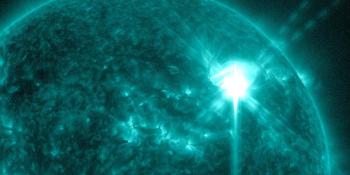Affichage des archives de lundi, 28 octobre 2002
Rapport d'activité solaire
Any mentioned solar flare in this report has a scaling factor applied by the Space Weather Prediction Center (SWPC). Because of the SWPC scaling factor, solar flares are reported as 42% smaller than for the science quality data. The scaling factor has been removed from our archived solar flare data to reflect the true physical units.
Rapport d'activité solaire et géophysique 2002 Oct 28 2200 UTCFait par le NOAA © SWPC et adapté par SpaceWeatherLive.com
Rapport de l'USAF/NOAA sur l'activité solaire et géophysique
SDF numéro 301 publié à 2200Z le 28 Oct 2002IA. Analyse des régions solaires actives et activité du 27-2100Z au 28-2100Z Solar activity has been moderate due to an M1/1n flare
at 1205 UTC from Region 162 (N25W59). Region 162 continues to show
flux emergence and consolidation in the western portion of the
trailer spots where the group has a delta configuration. Additional
frequent C-class subflares were produced by this region throughout
the day. New Region 173 (S17W69) emerged on the disk today and new
Region 172 (S17E44) was assigned. An erupting prominence was
observed near the northeast limb beginning around 2200 UTC and was
associated with a narrow CME in LASCO as well as a type II sweep
with shock velocity of 1015 km/s. The event was promptly followed by
a back-sided full halo CME which was first observed in LASCO at 2326
UTC.
IB. Prévisions d'activité solaire
Solar activity is expected to be
moderate because of Region 162. There continues to be a slight
chance for major flare activity from this region as well. The
current observations of strong activity behind the east limb suggest
that there is likely to be a gradual increase in background levels
and activity levels over the next three days.
IIA. Résumé de l'activité géophysique du 27-2100Z au 28-2100Z
The geomagnetic field was unsettled to active. Solar wind signatures
continue to indicate the presence of a high speed solar wind stream
associated with a coronal hole. The greater than 2 MeV electron
fluxes reached high levels today.
IIB. Prévision de l'activité géophysique
The geomagnetic field is
expected to be mostly unsettled for the next three days as the
currently enhanced conditions are expected to subside.
III. Probabilité d'éruption solaire du 29 Oct au 31 Oct
| Classe M | 60% | 60% | 60% |
| Classe X | 10% | 10% | 10% |
| Proton | 10% | 10% | 10% |
| PCAF | green | ||
IV. Flux Penticton 10.7 cm
Observé 28 Oct 158 Prévisionnel 29 Oct-31 Oct 155/155/160 Moyenne des 90 derniers jours 28 Oct 176
V. Indice géomagnetique A
Observé Afr/Ap 27 Oct 013/022 Estimé Afr/Ap 28 Oct 014/016 Prévisionnel Afr/Ap 29 Oct-31 Oct 012/012-012/012-010/012
VI. Probabilités d'activité géomagnétique du 29 Oct au 31 Oct
| A. Latitudes moyennes | |||
|---|---|---|---|
| Actif | 30% | 30% | 25% |
| Tempête mineure | 20% | 20% | 15% |
| Tempête majeure/sévère | 10% | 10% | 05% |
| B. Hautes latitudes | |||
|---|---|---|---|
| Actif | 35% | 35% | 30% |
| Tempête mineure | 25% | 25% | 20% |
| Tempête majeure/sévère | 10% | 10% | 05% |
Dernières nouvelles
Forum
AR3664 178[CME] AR 13664, X1.04, 2024-05-08 8Incoming Active Regions 239AR3663 248Sporadic E and Flare activity 22
Plus de messages du forumAidez SpaceWeatherLive.com !
Vous êtes de plus en plus nombreux à consulter SpaceWeatherLive pour suivre l'activité solaire ou aurorale, et avec le traffic les coûts du serveur augmentent. Si vous appréciez SpaceWeatherLive, soutenez notre projet en faisant un don afin que nous puissions continuer à vous informer !

La Météo Spatiale en faits
| Dernière classe X | 08/05/2024 | X1.0 |
| Dernière classe M | 08/05/2024 | M4.0 |
| Dernier orage géomagnétique | 06/05/2024 | Kp5 (G1) |
| Jours sans taches solaires | |
|---|---|
| Dernier jour sans taches solaires | 08/06/2022 |
| Nombre mensuel moyen de taches solaires | |
|---|---|
| avril 2024 | 136.5 +31.6 |
| Last 30 days | 161.2 +69.2 |


